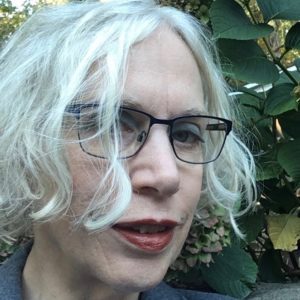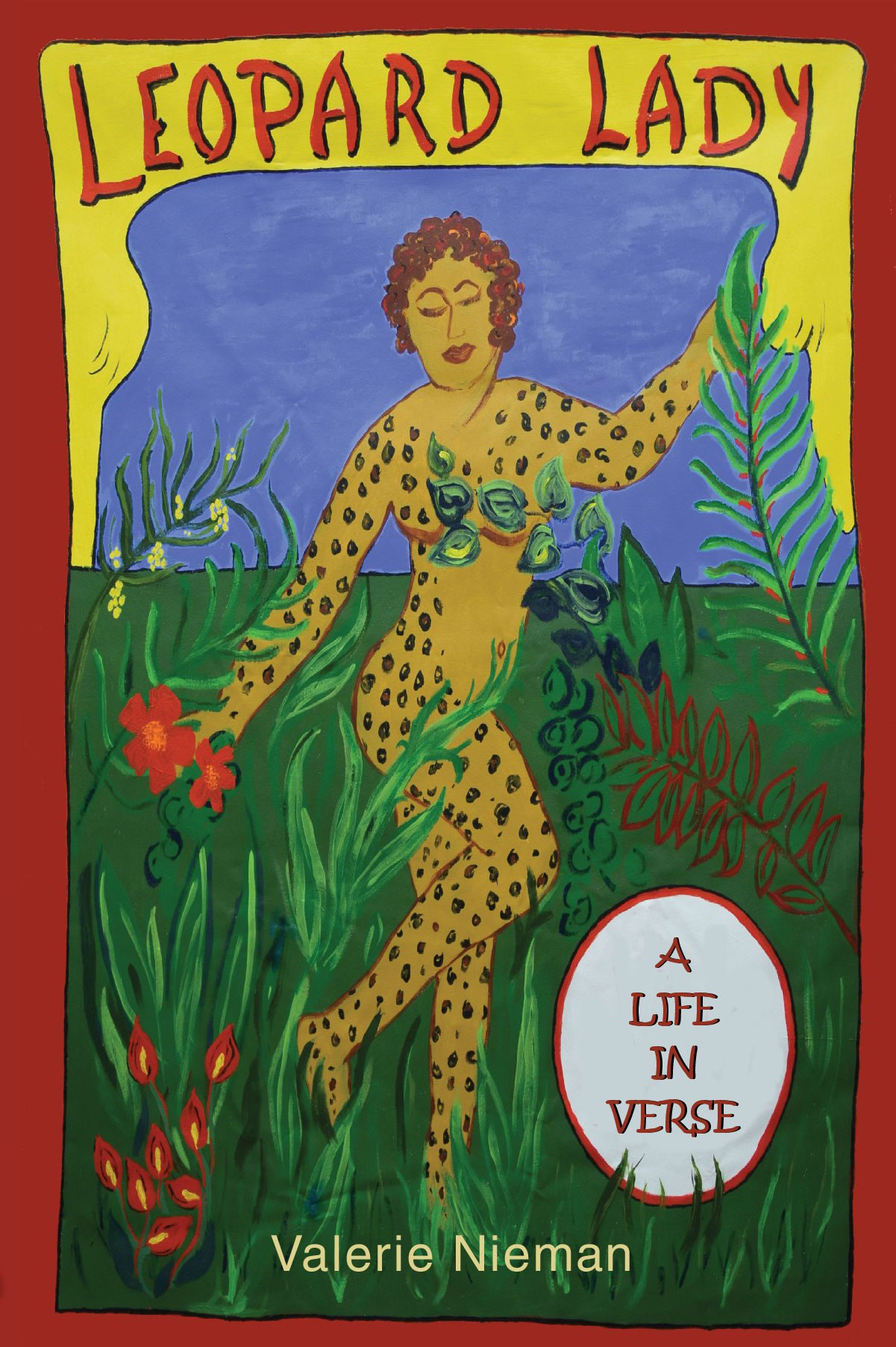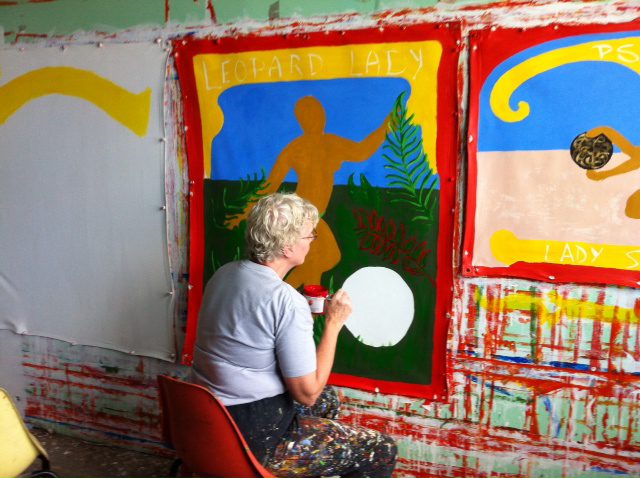
Valerie Nieman has published four novels and three books of poetry. Her writing captures the spirit of a woman trying to survive in the natural, and sometimes supernatural, world. In her poems, nature is often simultaneously beautiful and cruel. Leopard Lady: A Life in Verse, Nieman’s latest poetry collection from Press 53, signifies a shift in tone, but not in context.
The book is mostly written in an Appalachian dialect in the voice of Dinah Gaston. She is a dark-skinned woman bearing blanched spots that make her appear leopard-like. She is also a seer, a mystic who tells fortunes. Orphaned at birth and given to a childless family, her journey culminates in joining, and being enculturated within, a carnival sideshow. Dinah’s physical appearance, often abhorrent to others in the world outside the carnival culture, allows Nieman to explore the larger questions of racism, prejudice, and cultural assumptions.
The first half of the book is written almost entirely in Dinah’s voice. The second half is written almost entirely in the voices of her compatriots in the carnival sideshow. As these voices meld, Nieman builds a culture that has life, fire, and intelligence.
I initially sent Nieman a set of questions for this interview by email, then met with her at NC A&T University, an HBCU, where she teaches creative writing as a tenured professor. Our conversation
***
The Rumpus: Your previous poems could be described as exploring the natural world in a straightforward poetic manner, as a woman trying to make universal connections. The delivery system in “Leopard Lady” is different. Describe it, and then describe how the idea for “Leopard Lady” evolved?
Valerie Nieman: It wasn’t so much an idea as an invasion. I was sitting on the screened porch of my North Carolina home. Thunderstorms were rolling around, and I was working on a poem that was going nowhere. Then I heard this voice. It wasn’t a voice I knew, though the Appalachian cadences sounded familiar. I started writing down some words and phrases. Thirteen pages of dictation later, I had the start of the book. Although I sometimes have a single poem come in a rush, and have often worked in personae, this was a whole new experience.
The voice of Dinah had a colloquial richness and assurance that unsettled me, so much so that I tried to push that voice aside. And I did push that voice aside for more than fifteen years. During that time, I wrote a novel and another poetry collection, but the Leopard Lady poems kept piling up. When I was finally prepared to gather up the poems and turn them into a collection, another voice asserted itself. The Professor, who provides a major plot development in the second half of this book, joined the show, and his voice became just as dominant as Dinah’s. He brought a world-weary soul and a divinity school education to the poems, a counterpoint against which Dinah would test her feelings and her ideas.
Rumpus: The poems are primarily set in Appalachia, with some forays into rural areas north and south, from the 1940s to the 1960s. Dialects are traditionally hard to write. How did this one emerge? Then, how, as a writer, did you manage to not make the dialect sound forced, or make the Leopard Lady seem unintelligent?
Nieman: Her voice was clear and insistent from the start. Among those early poems was “Devil’s Work,” where she talks about gaining the second sight. She feels compelled to “reach / blind-handed / into the next day, / put fingers in the toes / of unshook shoes/and roust the fiddleback…” It’s the voice of a country woman who knows how to do everything from planting corn to foraging in the woods, wrangling cattle to canning on a wood stove. It’s also the voice of someone who’s been wronged more than once, but she raises her head and keeps on going.
Her voice is Appalachian, but there’s a mixture of other elements. Dinah’s no fool. Her formal education was limited, but she taught herself with the King James Bible and a volume of Shakespeare. She’s also a woman of color raised in an isolated white household, and a member of a carnival, where she absorbed the jargon of that culture. To suggest her voice, I listened for her phrases and quirks of speech.
Rumpus: References about disenfranchisement keep popping up. Dinah finally finds a home at the carnival and lives comfortably among the so-called “freaks” beyond traditional society. She makes no excuses for her life. Could you speak about how the character negotiates her life?
Nieman: It’s a long path for Dinah to claim control over her body and her destiny. She suffers servitude and sexual abuse before she arrives at a place where she can decide her own fate. She says in “Sometimes Wishing” that “I had nothing to call mine, / not even myself / not like now when I have / my own place with my bits and pieces.” The carnival show, alien as that environment might seem, is easier for her to negotiate because she has fewer expectations of what is “right and proper.”
Rumpus: The Leopard Lady claims she is “half one thing half another,” but her skin is dark. She is not a leopard, but she has spots. Can she easily be classified, or is that your point? What accounts for the spots on her skin? Genetics? Disease?
Nieman: The spots are real. It’s called vitiligo, an autoimmune disorder that arrives mysteriously and causes a dramatic alteration to a person’s appearance. The body literally consumes the melanin that gives the skin its color. The damage is bilateral, meaning that wherever color disappears on one side of the body, it also disappears on the other side. Vitiligo appears in people of all complexions, but the darker the skin tone, the more startling it is. Many people with such spots in the nineteenth through the early twentieth century worked in sideshows. They were called leopard girls and spotted boys, or billed as “a black man turning white.” All of them, as far as I know, were of African descent.
Dinah speaks of this process by invoking her mother “folded / inside me, blood and bone. / She’s working to get out, though, / showing herself. / That white woman what left me / is taking me back, / inch by inch.” Her own history is entirely secondhand, and not reliable. She believes that her mother was a white woman who died giving birth to her, and that her father was a black man. She is reared in isolation by a white family. The first black man she meets tries to instruct her in the world, saying, “Colored blood powerful, / more’n any other blood. / One drop can turn a white man black.” When she joins the show, she gets a brutal introduction to her status as a woman, and a black woman, in mid-century America.
Rumpus: Are you the Leopard Lady? If so, how?
Nieman: I have vitiligo, but my loss of color is much less startling. The areas without color are basically albino and very sensitive to sun, so I try to stay covered or sun-blocked. Recently, a woman with vitiligo has emerged as a fashion model, showing what used to be considered a disfigurement as something essential to who she is. A discussion has started about this disease. Like many other movements for acceptance, this one speaks to a problem that the wider society first feared, then ridiculed or despised, then simply avoided.
This condition is one point where my story intersects with that of the Leopard Lady. I’m also Appalachian by birth and long residence, though I’ve lived in the low hills of the Carolina Piedmont during the years this book has taken shape. Maybe there’s a bit of homesickness in the poems, a fact that Dinah admits to herself.
Rumpus: The Leopard Lady must drop her red kimono and reveal herself and her spots to men, who get to see her “affliction” only if they pay a fee. That’s certainly humiliating and sexist. Yet, there’s also the sense that the Leopard Lady feels pride in who she is. What were you thinking as a woman? As a writer?
Nieman: The sideshow, or “freak show,” while rooted in exploitation, also offered a sort of refuge for people with various genetic differences. It was a community where they could live and work. They had a freedom on the road that they likely wouldn’t have had in their homes or villages. Often, they had to struggle for money and their independence, but they could also live quite comfortable lives. The famous Siamese twins, Chang and Eng, used money from their exhibition to retire and buy adjoining farms in North Carolina, where they married sisters and raised large families.
Dinah knew a world of exploitation and sexual abuse before the sideshow. She runs away as a teenager, only to suffer the same fate with the man who helps her escape. When he abandons her at the carnival, a fortune-teller, Mrs. Elderia, takes her in, but Dinah must find work if she is to stay. She first becomes a “hootchie kootchie,” or exotic dancer. It’s not until Dinah hones her natural psychic gifts and receives training with Mrs. Elderia that she develops a marketable skill. As a palm reader, she finally begins to get control over her life and body.
Dinah has known love and loss, and she comes to terms with her physical affliction, as do others in the sideshow whose genetic inheritances make them into the Snake Man or Frog Boy. These are all roles they play for money. The roles, distorted by the impresario Professor to entice a paying public, are not so much different from the ones we perform to earn our living.
Rumpus: The second half of the book allows readers to be voyeurs and look over your shoulder as you unveil the Leopard Lady’s friends, lover, and colleagues within the sideshow community. Are any poets cloaked in the guise of her sideshow companions?
Nieman: Every character has bits and pieces of real people in their makeup, most notably the writer his/her self. The danger lies in those who insist on believing this or that event must have happened to the writer for her to write about it. Observation, life experience, and empathy twist and blend portions of “the real world” into the world that the poem demands. I will say that the Leopard Lady has men move into and out of her life, and she loves two of them. Maybe they are composites of a dozen people. Maybe they are parts of the same person.
Rumpus: Racism, prejudice, bigotry, and exclusion occur throughout this book and reflect how cultures thought and acted in the mid-twentieth century. What first triggered this book? The story or the politics?
Nieman: The Lady herself. I was thinking of neither story nor politics in those first encounters. I was just trying to hang on and see where she’d take me. When she coped with back-alley abortions, that was a response to the abuse she’d suffered and lack of other options. When she’s bluntly confronted with how society, even in the show, assesses her worth as a black woman, she survives and, eventually, thrives.
Working to complete the book, my method, other than letting the voices fill the page, was to draw on my own memories of carnivals and musty exhibits at Ripley’s “Believe It or Not” museum in Niagara Falls. I read Leslie Fiedler’s Freaks, and watched the movie of that name. I did research about carnivals, sideshows, working acts, and “naturals,” or born freaks. I also spent several days at Coney Island, where I learned about the art of the carnival banner. I painted one for Dinah, and I was able to watch performers in the Sideshows by the Seashore.
Rumpus: The Leopard Lady is also a fortune teller called Sybil and then, when the spots appear, Lady Panthera. She reveals herself and her spots to the masses out of necessity. She becomes a seer because she believes it’s her calling to predict the future. Can you speak about the connection between these two worlds?
Nieman: Dinah’s seeing the future is a wild gift. She likens it to a seed pushing through the earth and opening. It’s not something she controls. Her good heart is often tested when, as a palmist in the carnival, she’s expected to give people a reassuring view of the future. Meanwhile, her own very real psychic abilities allow her glimpses of danger and disasters that lie ahead. In the poem “Waiting Seed,” Dinah sees the future of a young couple. She says, “The man is hatchet, fire, bullet. / I see the curl of his lip. / The man is rope and bludgeon. / Not yet a killer, nary a word spoke against him, / but the seed is waiting to send down a black root.”
As with the story of Cassandra, people generally don’t want to hear the truth.
Rumpus: Who is this book’s best audience?
Nieman: We’re all freaks, all wanderers, all seekers. Dinah is one of us, and we are her. As unusual as her world may appear, her emotional arc is one we recognize. We look over her shoulder and we see ourselves.
***
Photograph of Valerie Nieman working on the banner art at Coney Island Museum by Professor Marie Roberts.






